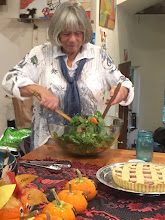In painting after painting John James Audubon has shown birds in action. His California vulture hulks on a branch, hump-shouldered, snake-necked, bald, watching, smelling, and waiting for carrion. His snowy owl twists a round head over a shrugged left shoulder. The body of his yellow-bellied cuckoo is acrobatically in motion: wings back, tail spread, beak open, neck stretched, the whole body in a yogic back arch, while his mate, a butterfly in her beak, rumples her wings and fans her tail feathers.
In such paintings as these Audubon captures birds in dramatic movement. In reality we usually see birds in flight, as in the shadow pictures of Peterson's guide, or perched on branches like goldfinches, hanging upside down from feeders like nuthatches, or clutching the sides of trees like woodpeckers and flickers. But yesterday at a small wooded swimming hole I saw a bird in motion that would have made Audubon grab his pencil.
 |
| Danish sandwiches at another picnic by a creek many years later |
But then into Paradise, exalting it by several degrees, flew a great blue heron. Flying upriver, he entered around the bend of the rock, his beak stretching out from the wide cup of his sleek neck, his great wings barely sweeping the air, his skinny legs horizontal. As soon as he came to our pool, he extended and opened his feet and held his wings in floating motion intending to land there and fish for dinner. But as he turned, he saw us and instantly changed his mind. In one unbelievable, sharp motion he drew in his left wing, twisted his body, retracted his landing-gear feet, turned, and joined flight again—downriver, gone.
I am not a painter, but I hold in my visual imagination the extraordinary form of the great blue heron, noble, blue-grey, lissome, and elegant, making a move that was both graceful in its success and astonishingly clumsy in its execution. The lines were not beautiful and svelte, like those of Audubon's snowy owl or yellow-bellied cuckoo. The wings were unbalanced in their action—one outstretched, the other tucked in—and the lines of the body were mixed, one wing crossed over the legs, the neck foreshortened, hiding its long, fluid line, but the in-flight movement that arrested the preparation for landing and simultaneously turned the great blue heron almost instantly in the opposite direction of his intent was one of the most beautiful things I've ever seen in nature.
Next week: "Three and a Half Pounds of Food"
Recipes from this post: Danish sandwiches
DANISH SANDWICHES
Suggested ingredients
Tomatoes, cherry or regular
Boiled eggs
Feta cheese
Cheddar or some other hard cheese
Cucumbers
Radishes
Avocado
Goat cheese (Montrachet)
Small bits of lettuce, radicchio, etc.
Herbs: dill, basil, parsley, etc.
Sardines
Salami
Black bread
Butter
Cold drinks
Also needed: A cooler for keeping ingredients cold.
To bring
Besides the ingredients listed above, be sure to bring a picnic cloth, two glasses, a small knife, and napkins. (Clothing optional.)
Preparation
This is a sandwich picnic, but the sandwiches shouldn't be made until time to eat. Boil the eggs ahead of time. Bring everything to the picnic spot in the cooler. When it's time to eat, spread the cloth on a flat spot. (Flat and small is preferable to larger but slanted.) Kneel on the cloth and set out the food. Open the drinks. White wine is the best cold drink, but sometimes a sparkling water is better.
To make
Slice the tomatoes, eggs, cucumbers, and radishes into rounds, the tomatoes into halves, and the feta into thick slabs, as they do in Greece. Butter some slices of bread. Put a layer of cucumbers, sightly overlapped, onto a piece of buttered bread. Add a similar layer of egg slices. Top with feta cheese. Make another sandwich of cucumbers, topped with Cheddar cheese, topped with tomato halves. Make another of eggs and tomatoes, no cheese. Sometimes top a sandwich with an herb. Continue to create various combinations of ingredients for little sandwiches. Go for aesthetics. Eat the sandwiches open-face, as they do in Denmark.




No comments:
Post a Comment